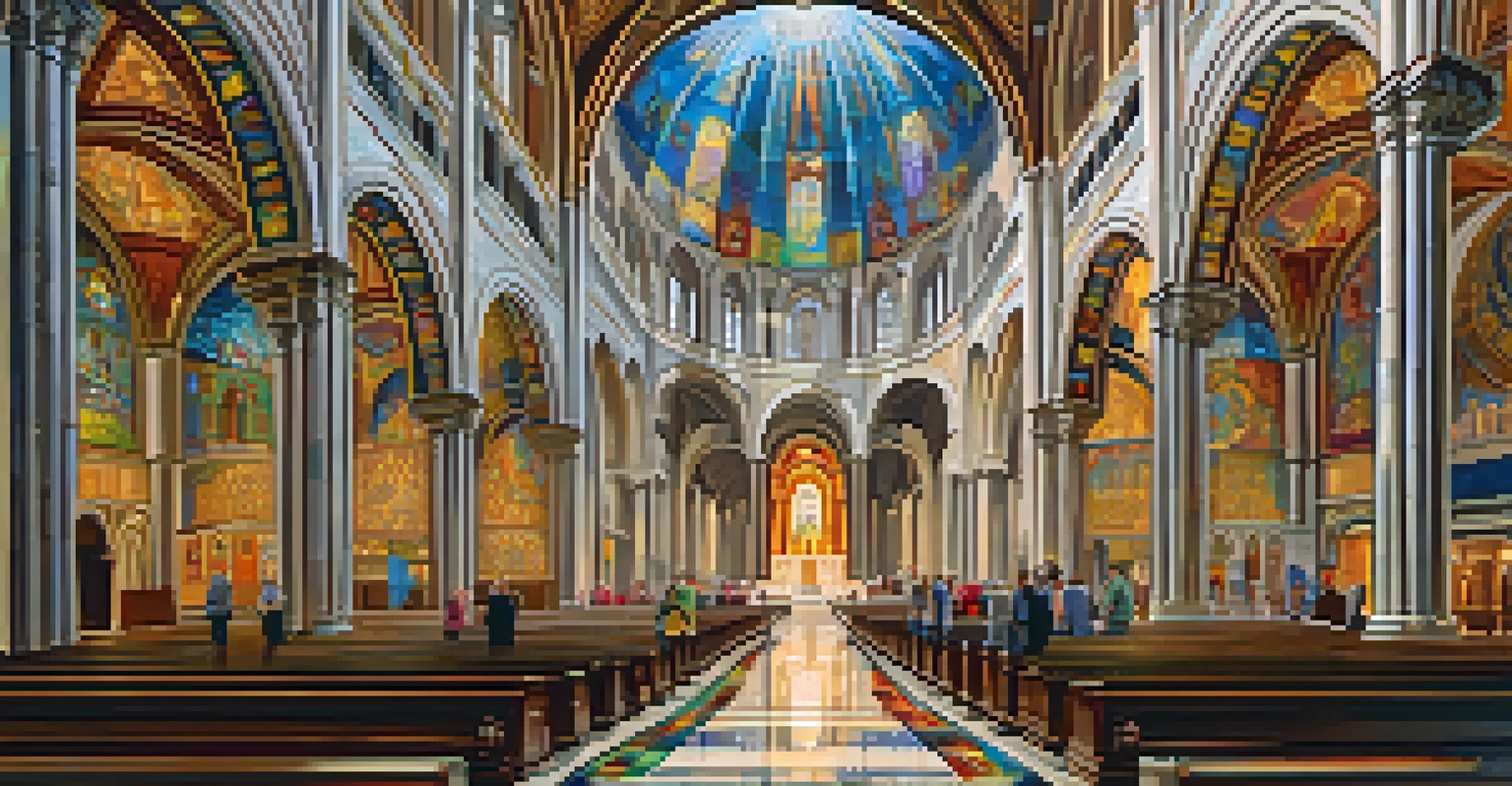Historic St. Louis: A Journey Through Architectural Heritage

The Foundation of St. Louis: Early Settlements and Structures
St. Louis began as a modest fur trading post in 1764, founded by Pierre Laclède and his 13-year-old step-son. The initial structures were simple log cabins, but they laid the groundwork for what would become a vibrant city. As the city grew, these early settlements reflected the influences of French colonial architecture, which can still be seen in some of the remaining buildings today.
Architecture is the learned game, correct and magnificent, of forms assembled in the light.
These early designs were not just functional; they also represented the cultural blend of French and Native American traditions. For instance, the use of local materials and techniques showcased a harmony with the natural environment. As settlers arrived and the population increased, the architectural style began to evolve, adapting to new influences and needs.
Over time, the humble beginnings of St. Louis transitioned into a bustling urban center, setting the stage for the remarkable architectural developments that would follow. This rich history is evident in St. Louis's diverse buildings, which tell the story of its early days and the people who called it home.
The Gateway Arch: A Modern Symbol of the City
Completed in 1965, the Gateway Arch stands as a monumental tribute to westward expansion in the United States. Designed by architect Eero Saarinen, this 630-foot stainless steel structure is not only an iconic landmark but also an engineering marvel. Visitors often describe it as a breathtaking sight, especially when viewed against the backdrop of the Mississippi River.

The Arch's unique shape resembles an inverted catenary curve, which is both aesthetically pleasing and structurally sound. This design was inspired by the idea of a gateway, symbolizing the city’s role as the 'Gateway to the West.' The surrounding park, known as the Gateway Arch National Park, enhances the experience, offering beautiful landscaped areas for reflection and enjoyment.
Rich Architectural Heritage
St. Louis's architectural landscape showcases a blend of historical influences, from early log cabins to Victorian elegance.
Beyond its physical beauty, the Gateway Arch serves as a historical reminder of St. Louis's pivotal role in American history. It draws millions of visitors each year, eager to learn about the city’s past and its forward-looking spirit, making it a must-see on any architectural tour of the area.
Victorian Elegance: The Soulard Neighborhood
The Soulard neighborhood, with its cobblestone streets and historic charm, is a testament to St. Louis's Victorian architectural heritage. Established in the early 1800s, Soulard is known for its beautiful brick row houses adorned with intricate ironwork and colorful facades. Walking through this area feels like stepping back in time, with each building telling its own unique story.
A building is not just a place to be, but a way to be.
One of the best ways to appreciate the architectural details is to take a leisurely stroll or join a guided tour. Many homeowners have lovingly restored their properties, showcasing the craftsmanship typical of the Victorian era. As you explore, you'll notice the variety of styles, from Italianate to Second Empire, reflecting the eclectic nature of the neighborhood.
Soulard is not just about history; it’s also a vibrant community known for its lively atmosphere, particularly during the famous Mardi Gras celebrations. This mixture of old-world charm and modern-day festivities makes Soulard a perfect example of how St. Louis honors its architectural past while embracing the present.
The Magnificence of the St. Louis Cathedral
The Cathedral Basilica of St. Louis is often regarded as one of the finest examples of mosaic art in the world. Completed in 1914, this stunning structure features over 41 million glass mosaic pieces, illustrating biblical stories and the history of the Catholic Church. Its grandeur is matched only by its serene interior, which invites visitors to reflect and admire its beauty.
Architecturally, the cathedral showcases a blend of Romanesque and Byzantine styles, making it a unique sight in the city’s skyline. The dome, which rises to 192 feet, provides a majestic focal point and is visible from various points in St. Louis. The artistry and attention to detail found within its walls are a testament to the dedication of the artists and craftsmen who brought this vision to life.
Modern Structures Enhance City
Contemporary buildings like Citygarden and the Pulitzer Arts Foundation reflect St. Louis's commitment to innovation alongside its historical roots.
Beyond its architectural significance, the Cathedral Basilica serves as a spiritual center for the community. It hosts numerous events, including concerts and art exhibits, allowing it to remain a vibrant part of St. Louis’s cultural landscape while preserving its historical significance.
Art Deco Dreams: The Famous Fox Theatre
The Fox Theatre, often referred to as the 'Fabulous Fox,' is a stunning example of Art Deco architecture, completed in 1929. Originally designed as a movie palace, its opulent interiors feature lavish detailing, including ornate plasterwork and magnificent chandeliers. The theatre’s design transports visitors to a different era, where elegance and entertainment were paramount.
One of the most striking aspects of the Fox is its grand auditorium, which boasts a starry sky ceiling that enhances the overall experience. The theatre has hosted a variety of performances, from Broadway shows to concerts, making it a cultural hub in St. Louis. Its historic charm continues to attract audiences, ensuring its place in the hearts of locals and visitors alike.
The Fox Theatre not only highlights the architectural trends of the 1920s but also represents the evolution of entertainment in St. Louis. As it thrives today, the Fox stands as a proud symbol of the city’s commitment to preserving its rich artistic and architectural heritage.
The Historic Districts: A Walk Through Time
St. Louis is home to several historic districts, each offering a unique glimpse into the city’s architectural past. Areas like Lafayette Square and the Central West End showcase stunning Victorian and Gothic Revival buildings that have been meticulously preserved. A walk through these neighborhoods can feel like a journey through time, with each block revealing layers of history and culture.
These districts are not just about the buildings; they also reflect the stories of the people who lived and thrived there. From the grand mansions of Lafayette Square to the charming bungalows of the Central West End, each structure carries the essence of its era. Many buildings have been repurposed for modern use, blending history with contemporary life.
Cultural Significance of Buildings
Each architectural gem in St. Louis tells a story, highlighting the city's vibrant history and its aspirations for the future.
Exploring these historic districts offers a deeper understanding of St. Louis’s evolution over the years. The preservation efforts in these areas highlight the community's commitment to maintaining their architectural treasures while fostering a sense of pride and connection to the city’s rich heritage.
Modern Marvels: Contemporary Architecture in St. Louis
While St. Louis is celebrated for its historical architecture, it also embraces modern design with open arms. Contemporary structures, such as the Citygarden and the Pulitzer Arts Foundation, showcase innovative architecture that complements the city's iconic skyline. These modern marvels not only enhance the urban landscape but also invite creativity and dialogue within the community.
Citygarden, an urban park that seamlessly blends art and nature, features contemporary sculptures amidst lush greenery. It serves as a focal point for both residents and visitors, providing a space for relaxation and artistic appreciation. The Pulitzer Arts Foundation, known for its minimalist design, emphasizes the importance of space in experiencing art, making it a unique destination in the city.

The inclusion of modern architecture in St. Louis reflects a city that values both its historical roots and its future. This balance creates a dynamic environment where innovation thrives alongside tradition, encouraging a vibrant culture that appeals to all.
Conclusion: Celebrating St. Louis's Architectural Legacy
St. Louis's architectural heritage is a rich tapestry woven from diverse influences and styles. From the early settlements to the modern marvels, each structure contributes to the unique identity of the city. Exploring these architectural gems offers insights not only into St. Louis's past but also into its aspirations for the future.
As you stroll through its neighborhoods, you can feel the heartbeat of the city—a blend of history, culture, and community. The preservation of these architectural treasures is a testament to the pride that residents take in their city, ensuring that future generations can appreciate and learn from their heritage.
In celebrating St. Louis's architectural legacy, we recognize the importance of both history and innovation. Whether you are a lifelong resident or a first-time visitor, the stories embedded in its buildings invite you to explore, appreciate, and engage with this vibrant city.